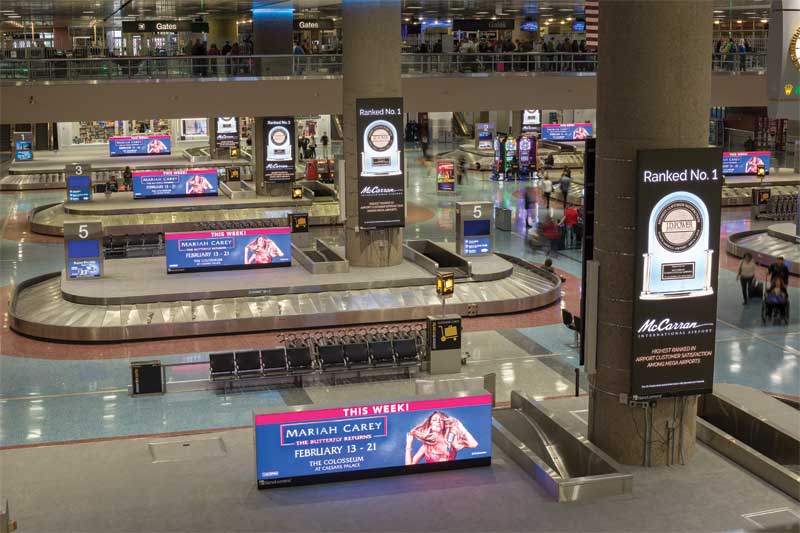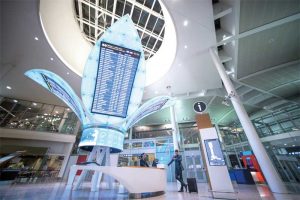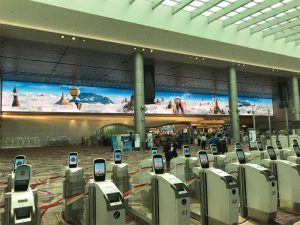The role of dynamic signage in the airport information economy
by | 28 April 2020 1:17 pm
By Eric Siegler
 [1]
[1]The size and brightness of the digital solutions allow passengers to gather necessary information from much greater distances, leaving hallways clear for others to move safely.
Thousands of travellers as well as airport staff pass through each of the busiest airports in Canada every year. These numbers increase annually and, with them, the infrastructure constraints of each airport and the expectations of travellers and airlines. Pressure constantly mounts on airport facilities to optimize their efficiency, enrich the passenger experience, and maximize the long-term viability of their existing infrastructure.
As is the case with any transportation hub, the on-site experience for customers and businesses in an airport is intimately tethered to the availability of communications. The logistics of moving passengers and employees through vast terminals on tight schedules can be impossibly complex, but precision and pragmatism are essential for a smooth experience. This requires comprehensive communication tools to ensure processes run efficiently, safely, and on time.
Many airports meet this objective with dynamic digital signage solutions, using the technology to deliver broadly applicable yet, highly specific, real-time information to large groups of transitory audiences. Not only is dynamic signage visible from much greater distances than traditional signage and can stand out amidst a sea of distractions, it also frees passengers to behave autonomously and enables airport administrators to focus on their operations rather than the needs of individual travellers. Though by no means a brand new technology, dynamic signage has expanded its future-proofed functionality in airport environments as a source for electronic visual information display systems (EVIDS) content, wayfinding, art, and advertising.
Instruction and information on the go
According to a survey by the global consulting firm Oliver Wyman, apart from flight delays and cancellations, frequent fliers consistently cite crowded hallways and insufficient wayfinding directions among their greatest challenges.
 [2]
[2]‘The Flower,’ a stunning light-emitting diode (LED) display feature, dominates the central gathering area of Terminal 1 at Toronto Pearson Airport (YYZ), transforming the space to one of the most highly trafficked locations at the airport.
When passengers cluster around small screens to find flight information, crowds grow in size and shrink in patience. Due to lack of accessible information, travellers wander aimlessly and further congest throughways without spending money. These crowds compromise an efficient passenger flow and are obstacles to airport staff, especially in the case of an emergency.
Dynamic signage helps supply information that far exceeds the demand of the crowd. The size and brightness of the digital solutions allow passengers to gather necessary information from much greater distances, leaving hallways clear for others to move safely.
For example, a North American international airport introduced a 9- x 3-m (30- x 10-ft) double-sided curved light-emitting diode (LED) display to address the issue. Previous displays proved hard to see with limited-viewing angles and distances, resulting in mounting crowds and confusion among the masses.
The new display—suspended in the middle of the facility—outshines ambient light in the area to provide passengers a nearly 360-degree view of flight information, eliminating the need for travellers to cluster around a specific area. While the size and brightness of the display allow audiences to view information including weather updates and news alerts from afar, the curve and pixel design allow easy access from a wide range of angles.
 [3]
[3]Many displays are used for advertising in addition to their passenger-focused duties, while many advertising-centric displays show information and wayfinding data.
Elevating the customer experience
Since passengers are restricted both in the beginning and at the end of their stay by security lines and departure times respectively, they want to be able to move about autonomously in the spare time they have.
Research experts have noticed a growing trend for ‘self-service’ among customers. Due to the proliferation of servicization and omnichannel selling, consumers have developed an expectation that everything they need should be at their fingertips; when this is not the case, customers sour. Dynamic signage serves as a solution to this problem primarily because customers can see what they need from a distance—not physically at their fingertips, but available immediately nonetheless.
The principal mandate guiding EVIDS and wayfinding signage is to offer passengers what they want in excess, so they can self-navigate. The directions they need are brighter, clearer, more flexible, and more visible when displayed on dynamic signage—whether it is dining options, shopping areas, restrooms, or other airport facilities.
For example, when renovating their International Arrival Customs Terminal, Vancouver International Airport (YVR) made sure passengers were able to access information quickly and easily. Travellers are now met with the sleek, minimalist design of a 9.7- x 2.7-m (32- x 9-ft) LED display welcoming them to the city, which also provides them relevant information about how to proceed from their gate.
Many airports have followed this lead and renovated their gate branding signage to incorporate dynamic LED displays. While a static gate sign can only specify the gate number, a dynamic LED wayfinding blade can display the gate number, flight details, weather, boarding status, and the time—all at once, changing each piece of information as new flights come and go throughout the day. With their questions answered even before they ask, travellers are free to walk around the terminal, especially since they know other displays will likely contain the same information should they need it again. Stress relieved, mood enhanced, and time freed, passengers will likely spend more money when roaming the space.
Augmenting information with entertainment
Along with informing crowds and directing traffic, airports offer other styles of communication to enrich the passenger experience. In environments where crowd flow is accounted for through other means, dynamic signage plays an important role in engaging travellers. Standing in security lines can be frustrating, and dynamic signage offers passengers something to engage with while they wait. For example, a 67- x 5-m (220- x 17-ft) LED display was installed at the security area of an international airport—not so much for the transmission of information, but rather to showcase enthralling visuals from digital storytelling experts.
 [4]
[4]While a static gate sign can only specify the gate number, a dynamic LED wayfinding blade can display the gate number, flight details, weather, boarding status, and the time—all at once, changing each piece of information as new flights come and go throughout the day.
A medium for culture
The airport environment is the first space a traveller experiences when they arrive in a new city; therefore, it plays an important role in communicating and celebrating the culture of the region it services. Forgettable esthetics remove people from their travel experience and insinuate comparisons between the blandness of the airport and the dullness of the city. Travellers do not just want to be somewhere; they want to feel somewhere, so airports have a duty to create that sense of place for their customers.
Dynamic digital signage can communicate culture in a more dramatic and pragmatic way. For example, ‘The Flower,’ a stunning LED display feature, dominates the central gathering area of Terminal 1 at Toronto Pearson Airport (YYZ), transforming what once was dead space to one of the most highly trafficked locations at the airport. The installation serves the primary purpose of branding the airport with Ontario’s provincial symbol of the white trillium, thereby welcoming passengers into the city’s unique environment and establishing a firm sense of place. That the displays also communicate flight information and weather details to busy travellers is a secondary function, which gives audiences another reason to engage with the artwork.
Some airports use LED signage exclusively for artistic purposes. For instance, a large digital installation at an international airport plays out on three massive LED displays and is a pulsing visual experience, using airport data to influence the constantly regenerating content. The fixture is a fusion of technology, art, and design, and reflects both the interconnected community of the city and its technological ascendance.
Enriching the airport infrastructure
One of the most obvious benefits of dynamic displays is showcasing a wide range of content. While mostly used for EVIDS and wayfinding content, airports can benefit from dynamic signage by selling advertising space to eager retailers. Not only will this help airport facilities to accomplish their primary goal of informing passengers, but generating revenue as well.
Many displays are used for advertising in addition to their passenger-focused duties, while many advertising-centric displays show information and wayfinding data. This versatility increases the value of the display space and the displays themselves.
As Arthur D. Little wrote in a paper on the digital transformation of airports for Amadeus: “By leveraging existing flight information display system (FIDS) infrastructure as an additional means to drive the in-airport retail offer, airports can achieve incremental revenue growth for only a moderate investment in existing infrastructure. This would see the role of FIDS change from flight information provider to multi-faceted marking tool.”
In addition to the direct ROI airports can collect through ad sales, dynamic signage has another advantage. According to research by J.D. Power & Associates, the mood of a traveller at an airport is correlated with the amount of money they spend there. While uninformed passengers will tend to crowd public spaces, disturb employees, spend less money, and leave with a sour attitude, well-informed passengers will proceed confidently through high-traffic areas and behave calmly and decisively in the face of unexpected variables. Such passengers are also likely to relax and indulge in paid airport experiences such as restaurants, retail stores, etc.
 [5]
[5]The brightness, size, off-axis viewability of these displays, along with their tendency to integrate seamlessly into nearly any architectural environment make the signage solution a powerful communication asset.
Optimizing the infrastructure
According to Little’s paper, executives across different airports ranked improving operational efficiency as their primary target benefit for investing in digital technology, specifically with regard to capacity enhancement.
Large-scale construction efforts to expand capacity for both passengers and airlines have transformed the terminals of some of the world’s largest airports. In keeping with these modernization and expansion projects, an international airport recently underwent a massive renovation to overhaul its capacity, but took smaller steps during the course of the project to optimize its existing infrastructure. Previously, passengers moving through one particular terminal gathered around a few inconsistent displays to receive their flight information. These crowds slowed foot traffic through the space and often rerouted passengers around an adjacent retail space when malfunctions occurred. The previous display solutions drove passengers to cluster, bluster, and not shop. In the face of these obstacles, the airport installed a curved digital display so passengers could view information, such as flight details, wayfinding directions, as well as advertisements, from a much broader range of angles and distances. As
a result, foot traffic was more streamlined, thereby reducing the need for airport staff to commit to crowd management and increase the pace with which they shuffle passengers from curb to gate.
Extracting value from existing infrastructure
Most airports target improving foot-traffic efficiency as a way to avoid costly construction projects. Due to a lack of resources, smaller airports are now turning to dynamic signage as a way to boost capacity by increasing flow rather than size. The brightness, size, off-axis viewability of these displays, along with their tendency to integrate seamlessly into nearly any architectural environment make the signage solution a powerful communication asset. As these displays are available in a variety of sizes and shapes, they can be affixed to unusual surfaces in uncommon locations.
Airports are often cavernous spaces with creative architectures. Dynamic signage easily embeds into these environments, thereby eliminating the need for massive renovations. As Little’s paper points out, “faced with the prospect of capital-intensive expansion projects that take years to deliver, digital technologies can, at the very least, be used in a tactical way to help airports extract the maximum value from their existing assets, especially by enhancing passenger flows.”
Adaptable to change in the moment and over time
Just as airport environments change at a moment’s notice, so too can dynamic signage. Whether it is EVIDS, experiential enrichment, or capacity maximization, these displays have evolved into a necessity at public spaces, especially airports. While some airports use dynamic signage as an informational tool, others use it primarily for artistic purposes. Many have even incorporated these displays as a way to optimize their existing infrastructure, while countless others use this signage solution to enhance capacity without expanding construction. Dynamic signage is so powerful in airport spaces that it is nearly impossible not to notice what it is communicating—which is in fact the entire point of the solution.
Eric Seigler is the global sales manager for airports and transportation at NanoLumens. A veteran technology sales professional with an expertise in digital displays, Seigler employs a nuanced understanding of the evolving needs of airports that has helped him position the company as the leading voice in light-emitting diode (LED) visualization solutions for airports across the globe. This article is based on a white paper he prepared for visual display integrators. For more information, visit www.nanolumens.com[6].
- [Image]: https://www.signmedia.ca/wp-content/uploads/2020/04/NanoLumens_McCarran_1.jpg
- [Image]: https://www.signmedia.ca/wp-content/uploads/2020/04/GTAA_INFORMATION_ZONE3.jpg
- [Image]: https://www.signmedia.ca/wp-content/uploads/2020/04/IMG_8291.jpg
- [Image]: https://www.signmedia.ca/wp-content/uploads/2020/04/London-Stansted-Airport__StanstedUK__2.jpg
- [Image]: https://www.signmedia.ca/wp-content/uploads/2020/04/NanoLumens_McCarran_2.jpg
- www.nanolumens.com: https://www.nanolumens.com/
Source URL: https://www.signmedia.ca/the-role-of-dynamic-signage-in-the-airport-information-economy/